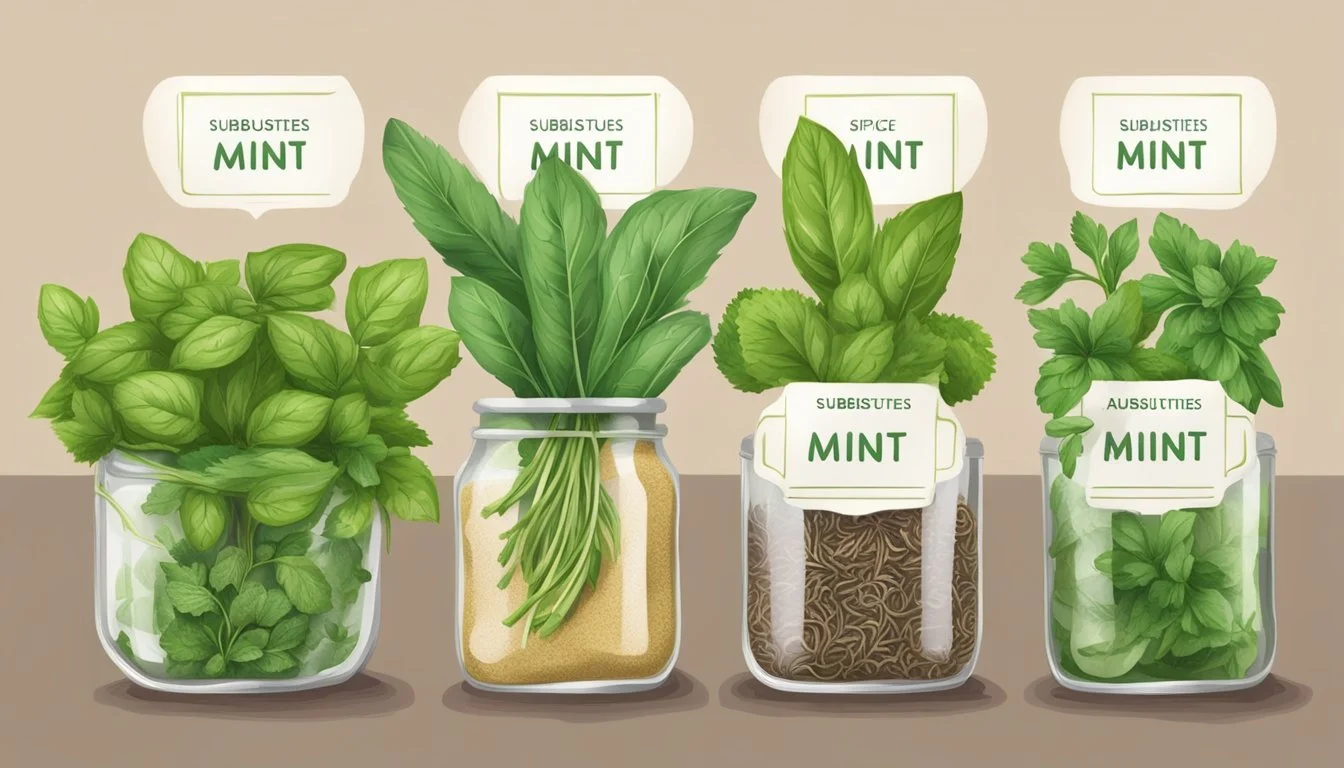Mint Substitutes
Top Alternatives for Cooking and Cocktails
Finding suitable mint substitutes can be essential for those moments when you're out of fresh mint or simply seeking a different flavor profile. Whether you're cooking a savory dish or crafting a refreshing cocktail, there are numerous ingredients that can serve as excellent alternatives. For a strong, minty essence, peppermint extract is a convenient option that requires only a small amount to mimic the flavor of fresh mint.
Dried mint serves as another great substitute, especially in recipes where fresh mint’s texture isn't crucial. It can be easily incorporated into sauces, marinades, or baked goods. Rosemary, being part of the mint family, also delivers a rich flavor that complements various dishes such as soups, stews, and salads.
There are also substitutes like basil and parsley, which offer their unique flavors while providing a hint of freshness similar to mint. Fresh basil works well in a 1:1 ratio with mint, making it a versatile choice in a variety of recipes. Parsley, particularly the flat-leaf variety, adds a bright, citrusy note without overpowering the dish, making it a subtle but effective alternative.
Understanding Mint and Its Unique Flavor
Mint is a versatile herb known for its refreshing, cooling properties and slightly sweet taste. It is commonly used in both sweet and savory culinary applications, thanks to its unique flavor and aromatic qualities.
Characteristics of Mint
Mint has a distinctive flavor characterized by a refreshing, cool sensation, primarily due to the presence of menthol. This compound activates cold-sensitive receptors in the mouth, providing a cooling effect.
The aroma of mint is herbaceous and invigorating, contributing to its popularity in food and beverages.
Mint leaves are typically bright green and aromatic, releasing their flavor when bruised or chopped.
Along with its flavor and aroma, mint oil derived from these leaves is often used in cooking, baking, and even in candies and gums to impart its distinctive minty flavor.
Common Varieties of Mint
There are several varieties of mint, each with unique characteristics.
Peppermint is perhaps the most well-known, noted for its strong, pungent aroma and high menthol content, making it ideal for both culinary and medicinal uses.
Spearmint offers a milder, sweeter taste compared to peppermint, often used in cooking and teas.
Chocolate mint is another popular variety, with a subtle chocolate undertone accompanying its minty flavor.
Each variety has its own mint leaves structure and aroma, allowing them to be suited for specific recipes or uses based on their flavor profile. These differences highlight how versatile and adaptable the mint plant can be across various culinary applications.
Culinary Uses of Mint
Mint is a versatile herb that plays a crucial role in enhancing the flavors of beverages, savory dishes, and desserts. Its aromatic profile and refreshing taste make it an essential ingredient in diverse culinary applications.
Mint in Beverages
Mint is frequently used in beverages, providing a refreshing and aromatic touch. Mint tea is a popular drink, often enjoyed for its soothing properties. Fresh or dried mint leaves are steeped in hot water to make this calming beverage.
In cocktails, mint is a star ingredient in the famous mojito, where it's muddled with lime and sugar, then topped with rum and soda water. Mint also serves as a key garnish in mint juleps and adds an aromatic top note to various summer drinks. Whether used as an infusion or garnish, mint elevates the refreshing qualities of many beverages.
Mint in Savory Dishes
Mint's bright flavor is a valuable addition to many savory dishes. It pairs exceptionally well with lamb, making it a common ingredient in lamb marinades and mint sauces. In Middle Eastern cuisine, mint is often mixed with yogurt to create a cooling dip called raita, which complements spicy dishes.
Salads also benefit from the inclusion of mint. For instance, a tabbouleh salad includes mint for a fresh contrast to the earthy grains. Additionally, mint can be chopped and added to salsas and chutneys, providing a crisp, cooling effect that balances richer flavors.
Mint in Desserts
Mint's refreshing taste makes it an excellent ingredient for desserts. A classic example is mint chocolate chip ice cream, where mint extract is used to infuse a cool flavor. In baking, mint can be incorporated into cookies and brownies, offering a delightful hint of coolness.
Mint is also used in dessert garnishes. Its bright green leaves add a decorative touch to cakes, puddings, and fruit salads. For a unique twist, mint can be infused into simple syrups to drizzle over desserts or mixed into cream for making mint-flavored whipped toppings. The herb's versatility ensures it can complement a wide range of sweet treats.
Herbal Mint Substitutes
In the realm of herbal mint substitutes, basil, rosemary, and tarragon stand out for their distinctive flavors and versatility in various recipes. Each herb offers unique qualities that make them suitable replacements for fresh mint.
Basil as a Substitute
Basil is a popular herb used in many culinary traditions. It shares some of the sweet and refreshing notes of mint, making it a viable replacement in certain recipes. Sweet basil adds a gentle aromatic profile that pairs well with both savory and sweet dishes.
Fresh basil works particularly well in tomato-based dishes, salads, and even some desserts. Chopped basil can replace mint in fruit salads, enhancing the dish with a mild sweetness while still offering a refreshing flavor. Although basil lacks the cooling effect of mint, its bright taste can complement a variety of ingredients.
Rosemary and Tarragon Substitutes
Rosemary and tarragon are robust herbs that can replace mint in various dishes. Rosemary has a strong, pine-like flavor that suits grilled meats, roasted vegetables, and hearty stews. It’s an excellent choice for dishes needing a more pronounced herbal character in place of mint's subtlety.
Tarragon offers a slightly sweet and anise-like flavor. It's particularly effective in chicken dishes, soups, and sauces. Tarragon brings a nuanced sweetness when a recipe calls for the freshness of mint. Both rosemary and tarragon can be used dried or fresh, depending on the recipe requirements.
These herbs bring their unique qualities to the table, allowing for creative adjustments in your recipes while maintaining a desirable balance of flavors.
Non-Herbal Mint Alternatives
For those looking to mimic the fresh, invigorating taste of mint without using the herb itself, there are several effective alternatives. These include citrus flavors, aromatic seeds, and concentrated extracts and oils.
Citrus Flavors as Substitutes
Citrus flavors can provide a zesty alternative to mint in various dishes. Lemon zest, for example, delivers a bright, fresh flavor that can uplift both sweet and savory recipes. Lime juice adds a sharp, tangy zing that's particularly effective in beverages and salsas. Lemon balm is another excellent option; it has a mild lemony flavor with subtle hints of mint, perfect for salads and teas. These citrus substitutes offer a refreshing kick without the need for mint.
Using Aromatic Seeds
Aromatic seeds like anise and fennel can also replace mint's distinct flavor profile. Anise has a sweet, licorice-like taste that can be used in baking and flavoring liqueurs. Fennel seeds offer a milder flavor, suitable for adding a unique twist to soups, stews, and meat dishes. While these seeds don't replicate mint exactly, their aromatic qualities provide an interesting and pleasant alternative, enhancing the depth of flavor in various recipes.
Peppermint Extract and Mint Oils
Peppermint extract is a concentrated form of mint that delivers a potent minty flavor with just a few drops. It's ideal for use in desserts, chocolate recipes, and cocktails. Mint oils, similarly potent, can be used sparingly in cooking to replace fresh mint. These oils are highly concentrated, so a little goes a long way, making them a practical and long-lasting alternative for achieving that refreshing mint flavor in a variety of dishes.
Selecting the Right Mint Substitute
Choosing the ideal substitute for mint relies on factors like flavor profile, aroma, and the type of dish being prepared. Additionally, understanding the correct quantities to use for different substitutes can enhance the overall balance of your recipe.
Factors to Consider
When selecting a mint substitute, the primary considerations include the flavor profile and aroma. Some substitutes like basil offer a sweet peppery taste, which can be ideal for salads and pastas. Others, like rosemary, provide a rich flavor suitable for stews and meats.
Texture can also play a role. For example, fresh parsley works well as a vibrant garnish, while dried parsley can be added during cooking. The intensity of the herb matters too, as dried herbs are more concentrated and require smaller quantities.
Cilantro (also known as Mexican or Chinese parsley) has a unique aroma that works in various dishes, while tarragon offers a slightly bittersweet flavor, fitting nicely in soups and meat dishes. Lemon juice can be a quick alternative for adding a zesty note, especially in sweet recipes.
Substitute Quantities
Using the right quantity of a substitute is crucial for maintaining the balance of flavors in a dish. Dried mint, for instance, is more potent than fresh mint, so less is needed. Typically, you would use one-third of the dried version compared to the fresh herb.
For other herbs like basil or cilantro, it's often a one-to-one substitution, meaning the same amount of fresh herb can replace the fresh mint. Mint extract is highly concentrated; typically, just a drop is enough for desserts and cocktails. Meanwhile, lemon juice should be added sparingly, typically starting with a small amount and adjusting to taste.
In summary, thoughtful consideration of factors like flavor, aroma, and texture, along with careful attention to quantities, will guide you in effectively substituting mint in any recipe.
Mint Substitutes in Specific Recipes
When substituting mint in recipes, it's essential to choose alternatives that maintain flavor balance. From salad dressings to sweet dishes, each substitute works best in particular culinary contexts.
Substitutes for Mint in Salad Dressings and Marinades
For salad dressings and marinades, fresh herbs like basil and cilantro can be excellent substitutes for mint. Basil offers a slightly sweet and peppery flavor that complements many types of salads and vinaigrettes. Cilantro, often called Chinese parsley, works well in Mexican and Asian-inspired dressings and marinades.
Dried parsley is another good option. It adds a vibrant touch without overwhelming other flavors. Fresh parsley can also be used, providing a mild and herbaceous taste.
Tarragon is suitable for more complex flavor profiles, especially in marinades for roasted meats and vegetables. Its slightly anise-like flavor pairs well with savory dishes.
Alternatives for Mint in Main Dishes and Sides
For main dishes and sides, rosemary and thyme can replace mint in casseroles, roasted meats, and vegetables. Rosemary has a robust, pine-like flavor that enhances roasted lamb and chicken. Thyme’s subtle earthiness fits well in casseroles and roasted vegetables.
Lemon balm is another alternative, especially in Mediterranean dishes like tabbouleh and salsas. It provides a lemony, mint-like flavor that brightens up grains and vegetables. Marjoram can also be used in chutneys, offering a sweet yet mild flavor that meshes well with meats and casseroles.
Tarragon remains a versatile option, suitable for a variety of meat and vegetable dishes.
Mint Substitute Options in Sweets and Baked Goods
In sweets and baked goods, peppermint extract and basil are common alternatives. Peppermint extract delivers a concentrated minty flavor without the need for fresh herbs. It’s perfect for cookies, cakes, and chocolates.
Basil can replace mint in recipes where a subtle herbal note is desired. It works well in fruit-based desserts and tarts. Lemon balm is another good choice, especially in baked goods and sweet sauces, providing a refreshing citrus twist.
Cilantro, though unusual in sweets, may work in innovative, savory-sweet dishes like certain pastries and fusion desserts.
Health Considerations and Benefit
Mint and its substitutes offer unique nutritional profiles and potential health benefits. Additionally, certain allergens and dietary restrictions should be considered when choosing the appropriate herb.
Nutritional Profiles of Mint and Its Substitutes
Mint and its substitutes are rich in essential nutrients.
Spearmint provides iron, vitamin A, fiber, folate, and manganese. These contribute to overall health and support various bodily functions, including blood health and digestion.
Basil contains vitamin K, which plays a crucial role in blood clotting, and antioxidants like beta-carotene. Cilantro offers vitamin C, potassium, and manganese, providing antioxidant and anti-inflammatory benefits.
Lemon Balm provides vitamin C and flavonoids. These compounds support immune function and possess calming properties.
Understanding these profiles helps in selecting the right herb based on nutritional needs.
Allergies and Dietary Restrictions
Allergic reactions to mint and its substitutes are generally uncommon but can occur.
Some individuals might experience an allergic response to basil or cilantro, which are related to the same family as mint. Signs of an allergy can include itching, swelling, and gastrointestinal distress.
Those with food sensitivities should also be aware of the potential for cross-reactivity between different herbs. For instance, individuals allergic to citronella or marjoram may also react to lemon balm.
When considering dietary restrictions, it's crucial to know that these herbs are naturally gluten-free and low in calories, making them suitable for most diets.
In summary, while herbs like mint and its substitutes are nutritious, it's essential to be mindful of potential allergens and dietary considerations to make informed choices.
Growing and Storing Mint and Substitutes
Growing mint and its substitutes is straightforward and offers numerous benefits, from fresh flavor to easy preservation. Proper cultivation and storage techniques ensure a steady supply of these herbs.
Cultivating Mint Substitute Herbs
Mint and its substitutes, such as lemon balm, parsley, basil, and rosemary, thrive in similar growing conditions. These herbs prefer well-drained, fertile soil and a sunny location with some afternoon shade.
Mint can be particularly invasive, so it's advisable to plant it in containers or designated herb gardens. Lemon balm and rosemary require regular watering but not over-saturation, while parsley and basil need consistent moisture but can suffer from root rot if overwatered.
Planting Time: Best started in spring after the frost.
Spacing: Allow 12-18 inches between plants to ensure adequate air circulation.
Feeding: Use a balanced organic fertilizer monthly during the growing season.
Harvesting and Preservation Methods
Proper harvesting and preservation techniques enhance the longevity and potency of mint and its substitutes. For the best flavor, harvest mint and its alternatives in the morning after the dew has dried but before the heat of the day.
Harvesting Tips:
Mint: Cut stems just above a pair of leaves.
Lemon Balm: Snip off the top leaves regularly.
Parsley and Basil: Harvest outer leaves first, leaving inner ones to develop.
Rosemary: Trim sprigs from the top, avoiding the woody base.
Preservation Techniques: Herbs can be used fresh or preserved through drying, freezing, or making herb-infused oils.
Drying: Hang bundles upside down in a dark, well-ventilated area.
Freezing: Place chopped herbs in ice cube trays with water or olive oil.
Infused Oils: Immerse fresh herbs in oil and store in a cool, dark place.
Storage: Dried herbs should be kept in airtight containers away from light and moisture to maintain their potency. Fresh herbs can be stored in the refrigerator wrapped in a damp paper towel inside a plastic bag.
This approach provides a year-round supply of flavorful herbs, ensuring that dishes always benefit from the freshest ingredients possible.






